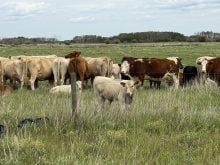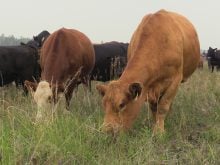This cattle market information is selected from the weekly report from Canfax, a division of the Canadian Cattle Association. More market information, analysis and statistics are available by becoming a Canfax subscriber by calling 403-275-5110 or at www.canfax.ca.
Fed prices strong
Western Canadian fed cattle prices continue to rally, achieving a new record high during the week ending April 25.
Read Also

Tick research from the University of Manitoba focuses on insects and testing
Manitoba researchers are looking into the effects of tick and fly disease in cattle.
After four weeks in a row of trading in the low $280s per hundredweight, Alberta fed steers strengthened by $5.03 to finish the week at $288.83 per cwt.
Similarly, Alberta fed heifers closed the week at $286.30 per cwt., $4.64 higher than the previous week.
Western Canadian steer carcass weights for the week ending April 18 declined to an annual low of 887 pounds, the result of more fed calves entering the processing system. This average is 25 lb. below the previous week, as well as the lowest carcass weight reported since last July.
Dressed sales were reported in the range of $480-$486 per cwt. delivered. This was $5-$11 per cwt. higher than the previous week . Cattle that traded were scheduled for delivery anywhere from immediately to the second half of May.
While all three western Canadian packers showed buying interest, interest from the United States continued to be minimal.
Canadian fed cattle and cow exports to the U.S. for the week ending April 12 hit a low of 4,839 head. This was 66 per cent lower than a year ago and the largest week-over-week decrease seen so far this year.
Canfax reports that this lower weekly export volume is a reflection of both the weaker U.S. dollar and the strengthened basis.
Year-to-date export volumes were 14 per cent higher than last year.
The Alberta cash basis reached -$7.36 per cwt. during the week ending April 25. This was the strongest basis seen in 2025 thus far, as well as the strongest basis since September 2024.
Light trade was reported in Ontario, with dressed sales at $480 per cwt. delivered, which was fully stead with the week prior. Cattle that traded were scheduled for delivery in the first half of May.
Cow market reaches impressive heights
The cow market was hot during the week ending April 25, with prices $45 per cwt. stronger than this time last year.
Non-fed volumes sold through commercial auction markets have been lighter than usual, though a few more calving-season culls have been brought to town recently.
Although one major packer was not active on the market this week, feeder cow buyers are reported to have been active. Cows purchased now to go on feed are likely to be aiming for the early summer market.
D2 cows have averaged more than $220 per cwt. for the second week in a row, setting new record highs.
Alberta cows are trading at a premium greater than $20 per cwt. against the U.S. market on a cash basis. This is the largest premium seen since 2018.
With tighter non-fed supplies, packers are anticipated to reduce their hours further.
The average price increase for the cow market from April to June has been eight per cent over the last five years. If this year is in keeping with this historical trend, Canfax predicts cow prices are on track to average in the low $230s per cwt. by June.
Cutouts stay steady
U.S. cutout prices remained full steady with the previous week, with early buying ahead of Mother’s Day thought to be helping these values.
Choice ended the week at $333.70 per cwt., while Select finished the week at $316.35 per cwt. The Choice-to-Select spread was $17.35 per cwt.
Stronger tone for feeder cattle
Most weight classes of cattle saw a stronger price tone for the week ending April 25.
Observationally, heifer volumes have been much greater than steers, a common occurrence for this time of year. Recently, heifers have made up 70 per cent of the total feeder cattle offering at several commercial auction markets.
Grass buyers remain active on feeders between 700-825 lb.
In Ontario, steers weighing 900 lb. and higher brought a significant premium compared to Western Canada.
Manitoba feeder cattle are moving east for finishing in Ontario instead of going west to Alberta.
The forward delivery market was tested lightly during this week. Alberta steers between 800-900 lb. for September delivery traded at a premium over the spot market

















